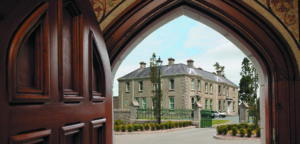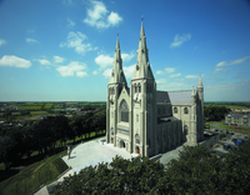ADDRESS TO PRIEST OF ARDAGH AND CLONMACNOIS
IN POOR CLARE MONASTERY CHAPEL, DRUMSHANBO
AT MASS OF THANKSGIVING
TO MARK 40TH ANNIVERSARY OF MY
EPISCOPAL ORDINATION
1967-2007
6th August 2007
First, may I express my sincere thanks to Bishop Colm for his kindness in arranging for this Mass to mark the 40th Anniversary of my Episcopal Ordination. I am so pleased to be once more in the company of priest from Ardagh and Clonmacnois, with whom I worked in the service of the Lord for fifteen of the forty years of my episcopal ministry, and I thank the priests for coming to join with me and Bishop Colm on this day. My words today will not constitute a homily, but rather a series of reminiscences; but I am sure that you will allow me some indulgence in nostalgia on ‘the day that is in it’.
On 23rd May 1969, I had a telephone call from the Nuncio – Monsignor Sensi, later to become Cardinal Sensi – asking me to come to the Nunciature by 10.30 next day. I knew that he must have some important reason for asking me to come, and I spent a sleepless night in my home in Belfast.
Next day the Nuncio told me that the Holy Father, Pope Paul VI, had appointed me to be the new bishop of Ardagh and Clonmacnois. This left me in a kind of daze. I knew very little about the diocese, except that my father was born there, in Keadue. That fact itself already constituted an important link with the diocese, and this helped greatly my settling in to the diocese as bishop, and, presumably, to my being welcomed into the diocese as bishop.
The date of the announcement of my appointment was fixed for Friday, 2nd June: it was the feast of the Sacred Heart and the First Friday of June – a very good omen for the future. Those days remain largely a blank in my memory and also in my diary: I was too dazed to record events except in the briefest terms, and often nor at all.
My first visit to the diocese, which was soon to become “my diocese”, was on Thursday 8th June. Accompanying by my younger brother, Patrick, I drove to Mohill to meet the Vicar General, Canon McLaughlin. He had a lovely lunch ready for me in the Parochial House in …, and after lunch he drove to Longford for my first view of St. Mel’s Cathedral and the Presbytery, and of the Bishop’s House, St. Michael’s, which was to be my new home. I met the Chapter in the Cathedral Presbytery and was very cordially welcomed by the Dean and Chapter. At a later date, closer to the actual ordination, I was formerly inducted into the diocese by the Chapter.
I noted in my diary that “the Cathedral is a delight, inside and out”. I noted also that I felt “happy and humble” with all that I saw and all those whom I met on that day of my first visit. Those early impressions and that first reaction were to be intensified over the next fifteen years. I felt humbled and privileged to inherit the pastoral care of a diocese where so many bishops and priests had laboured before me and had helped to form a faithful laity: in the words of the gospel, others had laboured and I had entered into their labours.
My pre-ordinational retreat was in a convent retreat house of German and Italian nuns at Vicarello, near Lake Bracciano, in a lovely setting not far from Rome, recommended to me by Monsignor Conway, then Rector of the Irish College. On the way to Rome, I had stopped off in Paris and at Lourdes and had celebrated Mass at the Grotto. At each new stage of my life I have had the opportunity to visit Lourdes and to place the next stage of my life’s journey in the hands of Our Lady. During the retreat I read and re-read and prayed over the Gospels and the Pastoral Letters of St. Paul, as well as whatever I had been able to find in Paris bookshops about the ministry of the Bishop. There is no kind of centre and no courses available for preparation for the office of Bishop. If there were, I suggest that the first person to apply for enrolment in such a course should first be sent for psychiatry assessment! … From my retreat at Vicarello, I still remember the cicadas chirping in the trees outside my bedroom window, and the murmur of the river which passed by the convent on its way to Lake Bracciano.
After the retreat and back in Rome, I had an audience with Pope Paul VI. He was most gracious and encouraging. And I told him that I had not pastoral experience and was apprehensive, he replied: “Don’t be afraid; Irish priests have a pastoral sense in their blood; and the priests and nuns and active laity in your diocese will help you”. I was soon to find out how true this was; I was supported by this help during my fifteen happy years in Ardagh and Clonmacnois. I mentioned my mother to the Pope and he immediately opened the draw of his desk, to find a rosary which he asked me to give to her: saying “Ask your mother to pray for me”.
The date, 16th July 1967, had been chosen for the ordination. It was the Feast of Our Lady of Mount Carmel. The ordination liturgy was called “Consecration” at that time. A little niece of mine was coming her parents to Longford for the ceremony, and was all excited about what was going to happen. She wanted, as children do, to share her excitement with her class and her school. So she challenged her schoolmates: “Do you know where I am going next Sunday?”. The reply, of course, was ‘No’. Then, triumphantly, she replied: “I’m going to Longford for the consternation of my uncle Cahal”. She spoke more wisely than she knew! My mind and memory of that day are a blur for me. I remember meeting the priests of the diocese and speaking of how I looked forward to working with them to implement in the diocese the splendid vision of the Church as set out in the documents of the Second Vatican Council.
My first formal meeting with the priests of the dioceses was at the Clergy Conference. These were held in St. M|el’s College, Longford, in the curate’s house in Carrick-on-Shannon, in St. Mary’s Presbytery, Athlone, and in Dean O’Kane’s house in Granard. The first one that I attended was in Granard. I still remember the warmth of welcome I received on each occasion. Dean O’Kane – a formidable patriarch – was particularly generous in his words of welcome. With his endorsement, I felt somewhat less apprehensive about the future.
A few days after the ordination, I had visited Clonmacnois, with my sisters, Sheelagh and Rosaleen. I remember calling in the Church at Tang, thinking that this was in my new diocese. Clonmacnois was and remains very special in my memories of Ardagh. I always added ‘and Clonmacnois’ when I refer to my new diocese. I particularly remember the annual Masses there for the young people of the diocese. Above all, of course, I remember the visit to Clonmacnois of Pope John Paul II. That was indeed an historic occasion, and no one who was present will forget it. It had a deep impact on Pope John Paul II himself, and he referred to it more than once afterwards as one of the highlights of his visit to Ireland.
As I look back on my fifteen happy years in the diocese, which I often call the ‘golden years’ of my life, some things stand out for me amid a host of memories which find me forever to Ardagh and Clonmacnois. First, there are the last two years of my mother’s life, spent in Longford, and her death in St. Michael’s, early in the morning of 28th January, 1974, with all the family gathered round her bedside. May she rest in God’s eternal peace. Then there is St. Mel’s Cathedral, the restoration work there and the new and reordered sanctuary and Blessed Sacrament Chapel, the tapestry depicting the Second Coming of the Lord in glory, and the Emmaus painting by Ray Carroll. Although not without pain at the time of the restoration, the Cathedral is now, even more than when I first visited it in June 1967, a place of prayer, of beauty and of peace.
There are humbling memories too. I remember one Christmas when, feeling out of sorts, I preached even longer than usual; frankly, I lost the thread of my homily but yet kept on talking! I had no defence when Father John Greene – one of the most honest men I ever met – came in to me next day and gave me a thorough dressing down. He told me that I was “killing religion in this parish with my long sermons”.
I shall nevertheless go on a little further to say that I remember the kindness and loyalty and the zeal of the clergy of this diocese, their pride in the diocese, their loyalty to their bishop, their brotherhood and camaraderie with one another. My class fellows, Tommy O’Brien and Michael Reid, have since passed on to their heavenly reward; but I sincerely felt all the clergy as my friends, and for this I thank you all.
I remember the kindnesses of all the Sisters of the diocese and the support which they gave to me in everything I tried to do.
This is the Feast of the Transfiguration, which, tradition tells us occurred on Mount Tabor. This is a conical-shaped mountain, raising steeply from the surrounding plain. A steep climb is needed to reach the top of the mountain. The road to the summit is a zig-zag one; anyone who has ever gone up that road in a Palestinian taxi will never forget the experience. It takes determination, persistence and perseverance to get to the top. At the top, exhausted and breathless from the climb, Peter and the others were rewarded by the sight of the glorified Lord and by the sense a power of the Divine Presence. Peter cried out: “Lord, it is good for us to be here”. It is good for us to be in the Lord’s presence when we pray. We bring the Church with us, we bring our own parish and diocese with us when we pray. To be men of prayer is the first condition of success in our ministry. We do need pastoral skills and pastoral planning, particularly at this difficult time in the life of the Church. But, more than any other skill, we need to be men of prayer. There is urgent need for more vocations to the priesthood; but, what the Church needs at this time is not just priests, but priests of prayer, holy priests. Let us pray, not simply: “Lord, give us priest”, but rather: “Lord, give us holy priests and holy bishops.”
May I add also a reference to the great concern we should all have for the decline in the vocations to religious life for women. We must never forget the immense contribution which our Sisterhoods in this diocese and all over this country have made to the life of the Church and of the nation. We shall perhaps not fully appreciate their contribution until their convents are empty.
However, let us not be down-hearted. Let us remember the words which Julian of Norwich says are addressed to her by the Lord Jesus himself:
“All shall be well
and all shall be well,
and you shall learn for yourself
that all manner of things
shall be well”.
The Lord is with his Church, and therefore with our diocese, till the end of time. Let us say to him, with total trust and confidence,
“For all that has been, Lord, Thanks.
To all that will be, Lord, Yes.”



You must be logged in to post a comment.